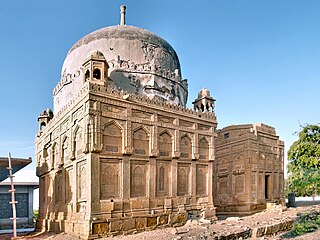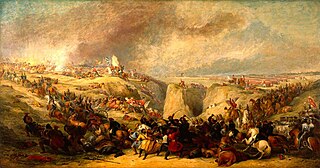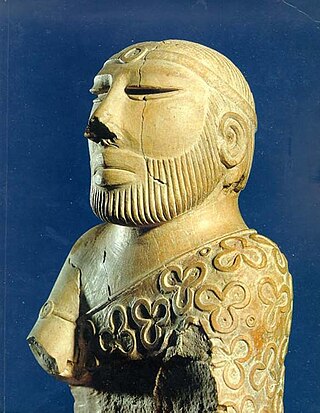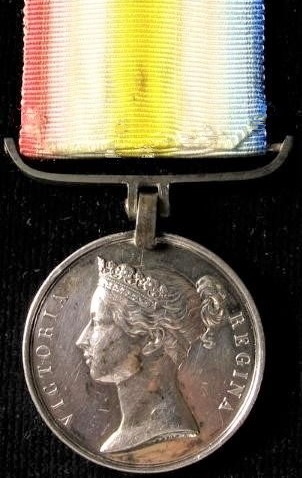
Hyderabad is a city and the capital of Hyderabad Division in the Sindh province of Pakistan. It is the second-largest city in Sindh, and the fifth largest in Pakistan.

Mirpur Khas is a city in Sindh province, Pakistan. The city was built by Talpur rulers of Mankani branch. According to the 2017 Census of Pakistan, its population was 205,913. Mirpur Khas is known for its mango cultivation, with hundreds of varieties of the fruit produced each year - it is also called the “City of Mangoes,” and has been home to an annual mango festival since 1955. After the completion of Hyderabad-Mirpurkhas dual carriage way, the city has become hub of commercial activities.

Dadu, is a city and the capital of Dadu District located in Sindh, Pakistan. The city is located on the western bank of River Indus and is administratively subdivided into four Union councils. Dadu is famous for its tea.

The Battle of Miani or Meeanee was a battle between forces of the Bombay Army of the East India Company, under the command of Charles Napier and the Baloch army of Talpur Amirs of Sindh, led by Mir Nasir Khan Talpur. The battle took place on 17 February 1843 at Miani, Sindh, in what is now modern-day Pakistan. This battle and the subsequent Battle of Hyderabad eventually led to the capture of parts of Sindh region, first territorial possession by the East India Company in what is the modern-day state of Pakistan.

The Battle of Hyderabad, sometimes called the Battle of Dubbo, was one of the major campaigns of the British against Sindh, which was fought on 24 March 1843 between the forces of the British East India Company and the Talpur Mirs of Sindh near Hyderabad, Sindh, Pakistan. A small British force, led by Captain James Outram, was attacked by the Talpurs and forced to make a fort of the British residence, which they successfully defended until they finally escaped to a waiting river steamer. After the British victory at Meeanee, Sir Charles James Napier continued his advance to the Indus River and attacked the Sindh capital of Hyderabad.
Mir Ali Murad Talpur, known as the Aadil-i-Jang, was the second ruler of the Mankani Talpur state of Mirpurkhas. He founded Mirpurkhas town in 1806 and made it the capital of his state which was founded by his father, Mir Tharo Khan Talpur at Keti Mir Tharo. His state included territories of the present day southeastern Sindh. His son, Mir Sher Muhammad Talpur waged a guerrilla campaign in Sindh against the East India Company after the British victory at the Battle of Hyderabad in February 1843, which resulted in Hyderabad falling under British control.

The history of Sindh refers to the history of the modern-day Pakistani province of Sindh, as well as neighboring regions that periodically came under its sway.

The area of Karachi in Sindh, Pakistan has a natural harbor and has been used as fishing port by local fisherman belonging to Sindhi tribes since prehistory. Archaeological excavations have uncovered a period going back to Indus valley civilisation which shows the importance of the port since the Bronze Age. The port city of Banbhore was established before the Christian era which served as an important trade hub in the region, the port was recorded by various names by the Greeks such as Krokola, Morontobara port, and Barbarikon, a sea port of the Indo-Greek Bactrian kingdom and Ramya according to some Greek texts. The Arabs knew it as the port of Debal, from where Muhammad bin Qasim led his conquering force into Sindh in AD 712. Lahari Bandar or Lari Bandar succeeded Debal as a major port of the Indus; it was located close to Banbhore, in modern Karachi. The first modern port city near Manora Island was established during British colonial Raj in the late 19th century.

The Talpur dynasty is a Baloch dynasty that ruled the entire Sindh from the overthrowing of Kalhora dynasty in 1783 until British conquest of Sindh in 1843. A branch of the family continued to rule Khairpur, under British suzerainty and later as a Pakistani princely state, until 1955 when it was amalgamated into West Pakistan.
Hyderābād City (Haidarābād), headquarters of the district of Sindh province of Pakistan traces its early history to Neroon, a Sindhi ruler of the area from whom the city derived its previous name, Neroon Kot. Its history dates back to medieval times, when Ganjo Takker, a nearby hilly tract, was used as a place of worship. Lying on the most northern hill of the Ganjo Takker ridge, just east of the river Indus, it is the third largest city in the province and the eighth largest in the country with an expanse over three hillocks part of the most northerly hills of the Ganjo Takker range, 32 miles east of the Indus with which it is connected by various routes leading to Gidu Bandar.

General Hosh Muhammad Sheedi Qambrani or Hoshu Sheedi was an Askari unit, and also supreme commander of Sindh's Talpur army led by Mir Sher Muhammad Khan Talpur. Hoshu Sheedi fought against the British forces under Sir Charles James Napier at the Battle of Hyderabad, and was killed during battle in 24 March 1843. Hosh Muhammad belonged to the Soomro community of Sindh, Pakistan. Before his death in the Battle of Hyderabad, he called out the famous slogan:
مرويسون پر سنڌ نه ڏيسون
Marvesoon par Sindh na desoon
(I will die but not give Sindh)
Mehrabpur, (Sindhi:محرابپور), is a city in the Naushahro Feroze District in the Sindh province of Pakistan. The city is administratively subdivided into 8 Union Councils. It has a busy railway station on the main railway line between Karachi and Lahore. It is a junction station with a disused branch line to Naushahro Feroze.
Kot Ghulam Muhammad is named after Ghulam Muhammad Khan Bhurgri, the Tehsil situated in south-east Mirpur Khas District of the Southern Province Sindh in Pakistan. Kot Ghlam Muhammad Bhurgri is situated west of Samaro and north of Digri. It is about 45 kilometres (28 mi) south of Mirpur Khas.
The Battle of Halani was fought in 1783 between the Baloch tribe of Talpurs and the Sindhi tribe of Kalhora near Halani village for the control of the Sindh region, in modern-day Pakistan. The Talpurs, led by Mir Fateh Ali Khan Talpur, won the battle over Mian Abdul Nabi Kalhoro of the Kalhora dynasty, and established the Talpur dynasty.

The Scinde Medal was authorised on 22 September 1843 and issued to soldiers of the Honourable East India Company, the 22nd Regiment of Foot of the British Army and members of the Indian Navy who crewed the Indus Flotilla, who participated in Major General Sir Charles Napier's conquest of Scinde between 1842 and 1843.

Tomb of Tharo Khan is the tomb of Tharo Khan Talpur, located in Mirpur Khas, in Sindh, Pakistan. The tomb is related to the Tombs of Talpur Mirs complex, built in the eighteenth century in the city of Hyderabad. The tombs are of the ruling Talpur Mirs of Sindh.
Mir Ali Bakhsh Khan Talpur was a politician and social reformist from Sindh, Pakistan. He was elected as member of National Assembly of Pakistan in 1970. He joined Baloch Movement in 1973 and then Awami Tahreek of Rasool Bux Palijo. He supported Mohtarma Fatima Jinnah against Field Marshal Muhammad Ayoob Khan, the Military dictator of Pakistan. He also opposed General Zia's Marshal Law. Despite owning thousands of acres of agricultural land, he spent his life trying to provide solace to the dirt-poor masses of Sindh.

The British conquest of Sindh was a successful British military campaign and conquest of Sindh into the British India from the rule of the Talpurs. The East India Company, supported by the British Army and Royal Navy, in India oversaw the campaign between February and March of 1843—two major battles were fought namely Battle of Hyderabad and Battle of Miani.

The Thatta Subah (1593–1737) or Sind State (1737–1843), was a Mughal subah, then a proto-state, and lastly a princely state in the Sindh region of the Indian subcontinent until its annexation by the British in 1843. The name Sind, now obsolete, was once the anglicized name of the state, which was also adopted by the British to refer to its division.











